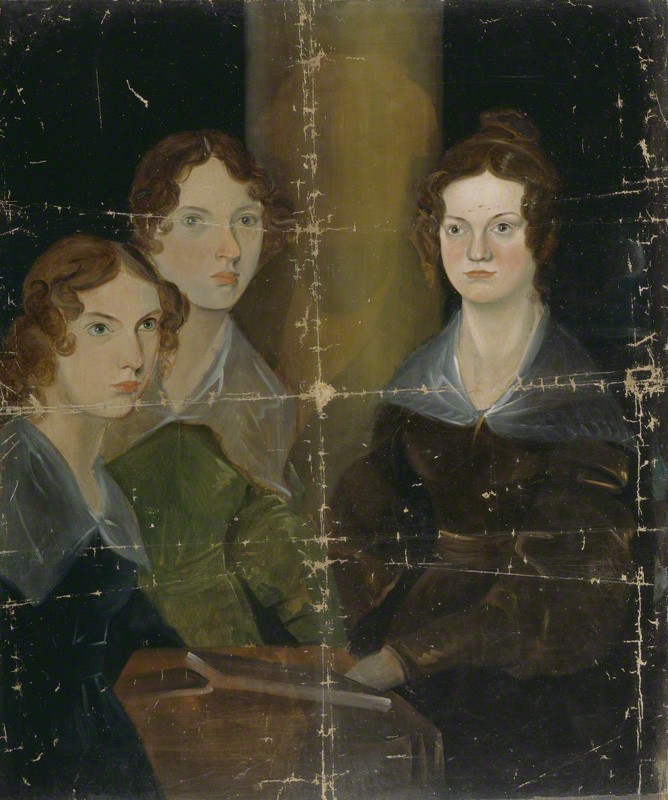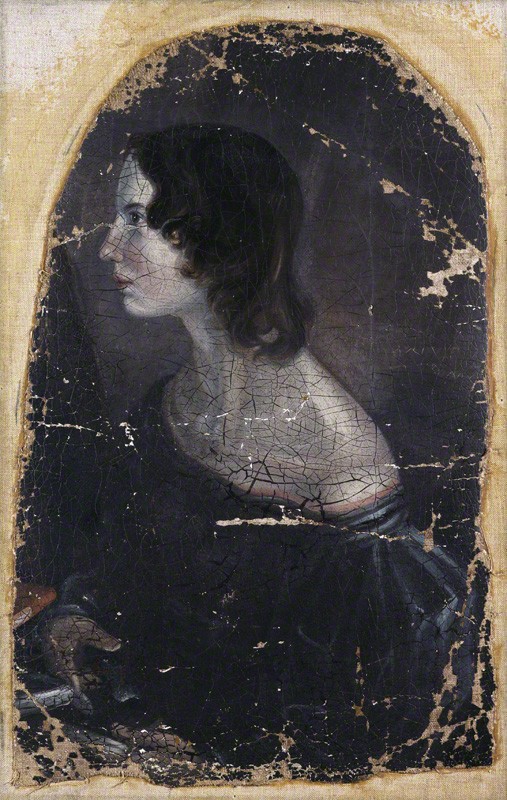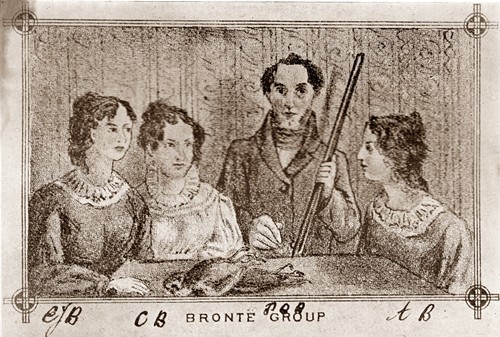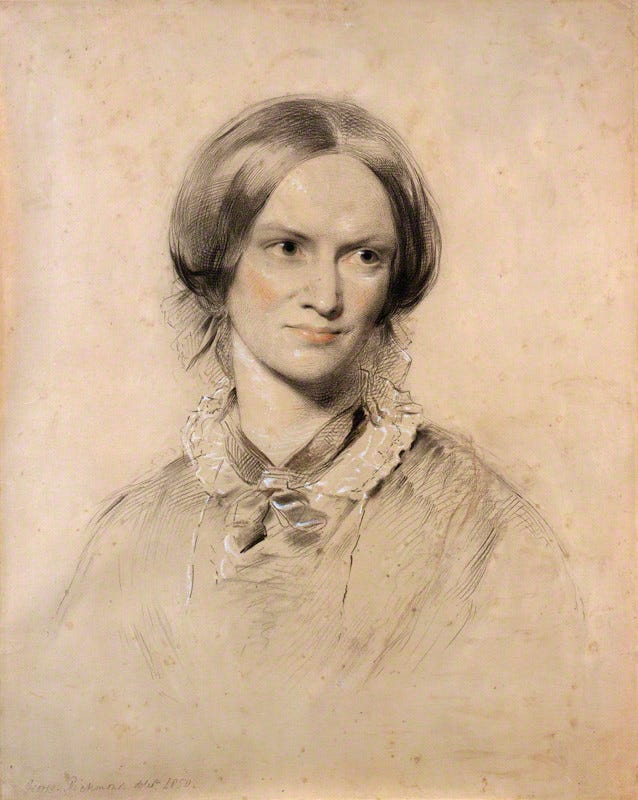The Shape Of Emily’s Coffin

Emily Brontë is buried under the floor of St. Michael and All Angels, Haworth, West Yorkshire. Photo by David Clay.
I read the books of the Brontë sisters in this order, starting when I was sixteen: Jane Eyre, then Villette, Wuthering Heights, the poetry of Emily Brontë, Agnes Grey, The Tenant Of Wildfell Hall, The Professor, and finally, Shirley. Then I moved onto biographies: Winifred Gérin’s of Charlotte, and then Anne, and then Emily. Then Elizabeth Gaskell’s biography of Charlotte, then Lyndall Gordon’s. Somewhere along the way, I read some of their brother Branwell’s work, and even picked up a vintage catalogue of the Brontë Society’s Library. Like thousands of young women before me, walking the tightrope from adolescence into adulthood led me straight into the arms of an obsession with the sisters from the north of England.
In writing, I preferred them thus: Emily, Charlotte, Anne. Or, sometimes Charlotte, Emily, and Anne. These days, I occasionally rate Anne first. But in biography, I alway preferred them in order of the quantity of documents they left behind, from most to least: Charlotte, Anne, Emily. Charlotte’s biographies are always massive, the most fully fleshed and juicy with lots of first-hand accounts. Emily’s are skeletal, vague, and full of conjecture, barely sketched. One should hope always, I think, to be an Anne, leaving behind not so much as a Charlotte — whose copious words were still burning up old acquaintances in Brussels upwards of fifty years after her death — but not so little as Emily. Emily is unknowable.
The real danger in leaving an Emily-sized cache of documents (i.e., almost nothing) is that people will usually mistake you for being exceedingly mysterious, no matter the truth of your day-to-day. In Emily’s case this irresistible penchant for myth-making (egged on by her mystical poetry and horrifyingly beautiful single novel) has led many of her most devoted followers to discard or at least gloss over the few things we do know about her: she was mean as a snake, she liked to cook and clean, and she was a horrific speller.
An understandable distrust of doctors (who in her day were little more than snake oil salesmen) during her final illness (consumption, it’s always consumption) has over time morphed into a death wish. This is a rumor good old Charlotte started not even two years after Emily’s death, in the Biographical Notice that she wrote to introduce an 1850 reprint of Wuthering Heights and Agnes Grey. Charlotte wrote, “Never in all her life had she lingered over any task that lay before her, and she did not linger now. She sank rapidly. She made haste to leave us.” Well, that’s one way of putting it. She had tuberculosis, babe. You think she rushed out the door to the grave to get away from you? Harsh.
Less than two hundred years later, in the hands of biographers and scholars, early Brontë Society goons and her sister Charlotte, Emily Brontë seems to have turned to dust. Because there are so few, the smallest biographical shred transfixes us and leads to all kinds of fanciful yarn-spinning. And though I know a spun yarn when I read one, and though I fancy myself something of a detangler rather than a spinner, one story in particular has always held my attention. One “fact” I’ve “known” for a long time is that Emily Brontë’s coffin was only sixteen inches wide, which was, I knew, very small. The thinness of her frame wasn’t lost on me; I was impressed with this fact every time I read it. It never occurred to me to question the veracity of this story, even though I live in a perpetual state of questioning veracity.

Emily Jane, the “notoriously elusive one,” born in 1818, was the middle of the three Brontë sisters who lived into adulthood (two died before they became teens, and Emily only made it to age thirty). Her tall, lanky frame, her lack of enthusiasm for food, especially towards the end of her life, has been depicted in later biographies as anorexia. A century and a half after her death, Lucasta Miller attributed the author’s mythic status not just to the lack of a true body of work, but to an actual lack of corporeality. “Her remains are so skeletal that the body seems to have gone missing altogether,” she wrote in her 2001 book, The Brontë Myth. Was it because she was so thin? Where had Emily’s body gone? And how thin was she exactly?
The Brontë sisters are a unit and, at least in biography, almost never sold separately. They lived together for most of their lives, broken up only by brief periods of school and (mostly for Anne) work as governesses. Legend tells us they wrote and edited their poetry and their novels together, pacing around the living room of the parsonage in Haworth where they lived, with their father, the widowed curate of the town. They submitted their manuscripts simultaneously to the same publishers. Their books, which have almost nothing in common with one another apart from being very good and being written in English, were conflated and sometimes advertised as the work of one person from their first publication. Between them, and leaving aside their poetry (which is insane, considering how great Emily’s is), they wrote some of the best novels of the nineteenth century.
One of the reasons the sisters Brontë — originally known by their deliberately androgynous pseudonyms Currer, Ellis, and Acton Bell — are often considered as a unit is, quite simply, that Charlotte is the only one who left behind a body of correspondence and personal effects large enough to warrant her own, standalone history. She lived long enough (to the old age of thirty-eight) and published often enough that she travelled to London several times, met famous people, became famous herself, and wrote hundreds of letters. Unlike the others, she had a portrait drawn by someone other than their brother Branwell (who was not a very good artist); hers was done in 1850 by the famous portraitist George Richmond.
People have tried, with varying degrees of success, to sketch full, book-length lives of Anne and Emily (not to mention their ne’er-do-well brother Branwell, who like Charlotte, left behind a corpus so vast it’s still being sifted through and recalled by the Brontë Society), but they are all quite thin in terms of documentation. Emily and Anne, whose novels were published by Thomas C. Newby, a less reputable house than Charlotte’s (Smith, Elder and Co.), left behind no manuscripts of their novels.
Neither Emily nor Anne kept a proper diary, though they did leave behind a few papers they each wrote on several of their birthdays, and manuscripts of their poems. Emily’s poetry survives in three handwritten notebooks, two of which are now in the British Library. Only three letters she wrote survive, including one in which she brags that writing a “proper letter” is a “feat that I have never performed.” There are several drawings, including some of her beloved pets, as well as handwritten essays she wrote as a student in Brussels. That’s it.
By the time Lucasta Miller began writing about Emily, the narrative of her being the hardest to pin down was well worn. In the New York Review of Books in 1972, Elizabeth Hardwick wrote, “No one and no amount of fact can give flesh to Emily Brontë’s character. She is almost impossible to come to terms with, to visualize.” Emily, so thin and unfathomable, is always described in terms of her body. She is skeletal. She is fleshless. And that is probably why we yearn to possess her.

Emily Brontë is literally “hard to visualize” in part because we don’t know what she looked like. There is only one confirmed likeness of her, and it hangs in the National Portrait Gallery. It was painted around 1834, when Emily was fifteen years old, by her brother Branwell.

NPG 1725, “The Brontë Sisters,” by Branwell Brontë ca. 1833. Seated, from left to right: Anne, Emily, a ghost, and Charlotte Brontë. Photo: The National Portrait Gallery.

NPG 1724, “Emily Brontë.” But it might be Anne. Photo: The National Portrait Gallery.
There is one other image thought to be of Emily, also at the National Portrait Gallery. It is the only remaining piece of what was once a larger portrait of the Brontë siblings. Known to Brontëphiles as the “gun group,” it was supposedly painted in 1833, unfortunately also by Branwell. Though the full portrait is thought to have been destroyed by Charlotte’s husband Arthur Bell Nicholls sometime after he’d moved back to Ireland and remarried, he saved just the one piece, cutting it from the rest. I wonder sometimes why he would save a portrait of Emily, throwing out the part that included his own dead wife, but that’s beside the point. There is happily a bad print of an engraving of the entire portrait, made in the 1870s. The fragment of the portrait (as well as the pillar portrait) were “discovered” in 1913 at Arthur Bell Nicholls’s house, and the print was discovered later. The fragment — NPG 1724 — was logged by the National Portrait Gallery in 1914 as “Emily Brontë,” but the identification was challenged two weeks later and has always been disputed. Is it actually Anne?

The 1870s engraving of the complete “gun group” portrait. The initialed identifications (which finger the National Portrait Gallery fragment as “AB” or Anne), were made by Charlotte Brontë’s best and lifelong friend, Ellen Nussey.
We know the Branwell portraits are bad likenesses. Compare his pillar Charlotte and the Charlotte chalked by the famous portraitist George Richmond in 1850. There’s no resemblance. None. And even if we accept (as has been argued so furiously in Brontë circles over the years) that Richmond was exceedingly flattering to Charlotte, Branwell’s maybe-two portraits of his sister Emily have no life. They tell us nothing. So what did Emily Brontë look like? A… person. With hair, eyes, and a nose. Beyond that, she seems to have been the tallest sister, at five-foot-seven — everyone (that I can find) agrees on that.

Charlotte Brontë, finally, thankfully portrayed by someone other than fucking Branwell.

The vast majority of people aren’t interesting enough to warrant a myth. But the author of Wuthering Heights—one of the most confounding and emotionally violent books in English literature—is. We’re coming up with new theories still: Just this week, The Guardian wondered (based on remarks made by Harman) whether Emily Brontë might not have had Asperger’s Syndrome (and of course, they used a portrait of Emily that definitely is not her). Peruse the index for the entry “Brontë, Emily Jane” in Winifred Gérin’s landmark (and first) full biography of Emily from 1971 and you’ll find: her freedom; her visionary power; her extreme reserve; her nickname (“The Major”); singularities of dress; growing perception of humanity’s burden; incident of mad dog; her aversion to publication; her contempt for her published work; extinguishes fire; her unsociability; her inflexible character; her increasing withdrawal — and so on.
But the anecdotes cited far precede Gérin; in fact, most of them date from the first, and the mother of all Brontë biographies, The Life of Charlotte Brontë, written by novelist and friend of Charlotte, Elizabeth Gaskell. Gaskell had access to her widower and father, her publisher, her juvenile manuscripts, and her friends’ collections of letters. Maids who had lived with the Brontës for decades, neighbors, school mates and teachers from their time as students in Brussels: Gaskell found them all, and she published a lively biography not simply of Charlotte but of the whole family.
Indeed, any Brontë biographer to date must first grapple with the legacy of Gaskell: was father Patrick Brontë really as bad as she described? Was Cowan Bridge (the real-life school Charlotte attended and which she used as a model in Jane Eyre) really so horrible? Was Branwell really as bad as… you see where this is going. Gaskell’s biography, important and accurate as it was, veered towards Gothic gloom and doom.
But it is also from Gaskell that we have the anecdote about Emily beating her pit bull, Keeper, into submission with her bare fists for some minor offense; and with Gaskell that the story of the “mad dog” whose wound Emily cauterized with a hot iron originates. From Gaskell we learn that Emily was rather unpopular with other school girls in Brussels, because she insisted on wearing gigot sleeves far past their trendiness.
And of course we can’t forget Charlotte’s contribution. The Biographical Notice of Ellis and Acton Bell served several purposes. It unmasked her sisters, and published their work under their real names; it served as an obituary and short biographical sketch. But it did more than that. Charlotte, left only with her sisters’ messy legacies, re-read the works: Anne’s Agnes Grey and The Tenant of Wildfell Hall, and Emily’s Wuthering Heights. Charlotte’s own publisher was set to send the novels into new editions and she took the opportunity to clear up the question of authorship. She established firmly that there were three authors, not one, as Emily and Anne’s unruly publisher Newby intimated in 1847 on the publication of Wuthering Heights and Agnes Grey, in the hopes of riding the success of Charlotte’s runaway bestseller, Jane Eyre.
In righting wrongs and establishing a legacy for her sisters, Charlotte was also denying having written these books — an important distinction given that none of them (particularly Wildfell Hall and Wuthering Heights) was well received or reviewed. In defending her sisters’ legacies after their deaths, Charlotte did not go to great lengths to defend their actual work. Though she acknowledged Wuthering Heights to be a work of great and “rustic” power, one comes away from the introduction with the suspicion that she didn’t quite grasp it fully. “Wuthering Heights,” she wrote, “was hewn in a wild workshop, with simple tools, out of homely materials.” Thanks for nothing, Charlotte!
If these scraps — the tale of the dog and the hot iron, the big sleeves, the death on the couch in the living room, the burnt hair comb passed from maid to maid (first recounted in Mary Frances Duclaux’s wildly fun but also wildly inaccurate monograph, Emily Brontë) — are some mixture of fancy and fact, as things really must be at this late stage in the game, what are we to make of the story about Emily’s coffin?

I first read about the coffin probably twenty years ago, and I’ve seen references to it ever since. The earliest mention I can find of the size of Emily’s coffin is from Gérin’s 1971 biography: “The village carpenter was sent for to make the coffin. In recording the measurements, he said he had never in all his experience made so narrow a shell for an adult; it was 5 feet 7 inches by 16 inches.” In 1998, Steven Vine wrote in his book Emily Brontë, “Brontë inscribed her desire on her flesh as hunger — and her body became, in the absence of speech, the very text of her deprivation. She died on 19 December 1848 and was buried three days later. Her coffin maker, William Wood, had to construct the narrowest coffin he had ever made for an adult; it measured just 16 inches across.” Ah yes, her body again. Her skeletal, deprived body. Something about her made a waifish-extreme-and-starving myth the easiest one to accept.
I was reminded of Emily’s coffin again this past spring, while reading a new bio, not of Em but of Char. Claire Harman writes, in Charlotte Brontë: A Life, “The coffin was the narrowest that William Wood ever recalled making for a grown person. It measured five foot seven by only sixteen inches wide.” My eyes sort of glossed over this at first. “Yes, yes,” I nodded, “this fact is known to me.” But something drew me back this time.
What does it signify — what does it mean to us — to read this over and over? Simply that she was emaciated because she was so very ill? Was she deprived of even taking up the normal amount of space for a woman? Did her lack of width speak to her ethereality? It is, at the very least, depressing, right? How wide is an average coffin? Would it be a lot less wide in 1848, owing to like, smaller people and bad nutrition? Is sixteen inches really very narrow? She did have tuberculosis after all, and five-foot-seven, that’s taller than average, right?
On the surface, this coffin “fact” is really well documented. Sixteen inches. William Wood. The coffin maker. (No, actually, the town carpenter — he also made cradles, tables, and chairs, in addition to custom coffins). I became so interested in him I spent half a day constructing his family tree. His surviving family later collected Brontëana and passed down some valuable drawings to various sources. I measured my own shoulders: nineteen inches. So, not that far off, really, but then again, also, way far off. My coffin would have to be at least twenty, twenty-five inches to accommodate me at my widest point. My shoulders. Right?

I emailed the Brontë Society (founded in 1893), which operates in Emily’s old home, the parsonage where she lived and died. “I’m trying to track down the source of the story that the Haworth carpenter William Wood said E’s coffin was just 16 inches wide. As far as I can tell Winifred’s biography might be the first published source of that bit but I am not positive. Any thoughts?”
The current librarian’s name is Ann, and she was quite helpful. She thinks too, that Gérin is the first published source of the coffin story. The information, she said, was taken from Wood’s account books, which are not in their possession. “I have heard,” she wrote, “that the originals were still in Haworth, possibly at the time Gerin lived in the village. At the Parsonage we have what appear to be copies of some of the Brontë-related entries from the accounts, which I think were produced by Mabel Edgerley, a member of the Brontë Society council. I don’t know if Gérin saw these or the originals.” Gérin was a local; she lived in Haworth for most of her life. Mabel Edgerley, who I’d never heard of until Ann’s email, sent me down another rabbit hole.
I applied for a job running the Brontë Society in my spare time. I had no qualifications to do so, but I was in deep (and, well, the job was open). Mrs. Edgerley, much revered in this world, ran the Brontë Society for seventeen years, from 1929 to 1946. She made copies of the account books, it seems, before they went away or disappeared, or whatever: nobody seems sure. I found portraits of Mrs. Edgerley online. Many of her letters and works are in the Brontë Society’s catalogue. Even her obituary is there. I found no evidence of the width of her coffin.
While researching how to make my own coffin, I came across Jonas Zahn, who runs Northwood Casket Company in Beaver Dam, Wisconsin. Helpfully, he also makes caskets himself. Not the way the big guys do it: Zahn makes each one by hand, custom built for each occupant, and because he is concerned with sustainability, he plants trees for every casket he makes. A hundred trees. He told me the difference between a casket and a coffin: a coffin is a six-sided funerary box, tapered at the bottom; a casket is rectangular and even. But, he said, the distinction between these two words is a modern one. Back then, only the word coffin was used, regardless of shape. Because she lived in nineteenth-century England, Emily’s was likely to be a coffin in the modern sense. I asked him if it were possible for hers to have been sixteen inches wide.
“Yes,” he said. “People were smaller then.”
He was straightforward and kept to the point, but everything he said was fascinating to me.
This is an era before there were standard lumber sizes, so the boards that were available were rough sawn boards. They were as big as the logs of the tree were. So they custom cut the boards to make a box, and they would have made the box to the exact size that the deceased person needed. They measured the person and then built the box. At that time, it was a very simple wooden box. And they would have fit tight. Today…because we do viewings…we want the deceased person to look comfortable. She would have been put in the box and there would have been a funeral quickly and the casket would be closed. The lining at most would have been a pillow, maybe a blanket really for a very practical reason.
He paused. “They would have put a blanket on the bottom just to catch any, uh, fluids that would be leaking from an unembalmed body.”
So it seemed I had my answer: a sixteen-inch wide coffin in 1848, doesn’t sound outlandish to a man who makes coffins. But I wasn’t satisfied. Zahn told me to talk to his friend, a funeral director.

Jimmy Olson, who owns and operates Olson Funeral Home in Sheboygan, Wisconsin, offers natural burial, a growing but still small pushback against the industrialized modern process of burying human beings. Naturally buried bodies go in either simple boxes, or in shrouds, right into the ground — as Olson says, “back to nature” — no chemicals, no embalming. He has also studied the history of funeral homes and burials.
“Have you ever looked at photos of Victorian people in coffins?” he asked. “That will give you a better idea of what [the coffins] looked like.” He painted a vivid picture of what Emily’s discarded body would have undergone, in the three days between her death and her burial inside the Church, just steps from where she died. Without embalming, the body would have had to go in the ground with some haste. Bodies decompose quickly, and the smaller the body, the faster it goes.
“You don’t decompose from the outside in, you decompose from the inside out,” Olson told me (reminded me, he said, but the truth was I’d never thought about it — I’ve spent a lot of years not thinking about it). “That makes sense,” I said. “You’re basically water,” he continued. Depending on conditions — climate, the box, placement of the cemetery, size of the person — he said, it could take eight to fifteen years for a body to decompose. An embalmed body in a heavy casket and a concrete vault takes much longer to decompose, but still, it happens.
A hundred and sixty-eight years later, there’s definitely nothing left of Emily. Just like everyone says, Emily Brontë is hard to get a hold of, because she doesn’t exist.
I eventually found a transcript of the coffin maker’s book. Here it is, in his own words: “Emlea Jane Bronty. Died Dec 19th 1848 in the 30 year of hir Age. Coffen 5ft 7” long 16” broad.” Mr. Wood did not spell well, but the description matches just what I’ve read previously.
“Do you think a sixteen-inch wide coffin is really narrow?” I asked Olson at one point.
“Not really,” he said.
I’ll have to take his word for it.
Laura June is a Staff Writer at New York Magazine’s The Cut. She used to have a weekly column at The Awl called The Parent Rap. She is writing a memoir for Penguin.